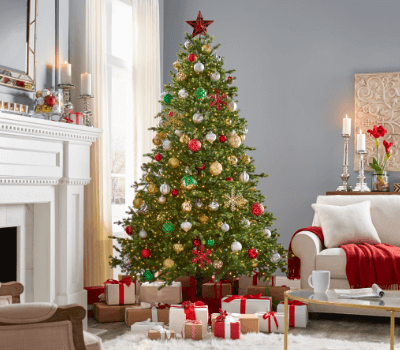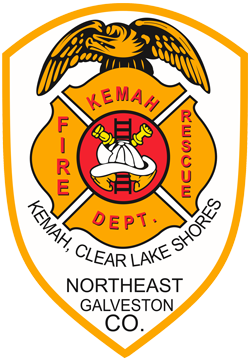
Christmas tress were involved in approximately 300 fires annually from 200 to 2004, according to the National Fire Protection Association. These fires resulted in average of 14 deaths, 21 injuries, and $16.8 million in property damage per year.
Purchasing the Tree
-
- When purchasing an artificial tree, look for the label “Fire-Retardant.” (Although this label does not mean the tree won’t catch fire, it does indicate the tree will resist burning and should extinguish quickly.)
When purchasing a live tree, check for freshness:
- A fresh tree is green.
- Needles are hard to pull from branches and when bent between your fingers, needles do not break.
- That trunk butt of a fresh tree is sticky with resin.
- When tapped on the ground, the tree should not lose many needles. A shower of falling needles indicates that the tree is too dry.
- Watch out for trees with a greenish cast to their trunks and branches; many growers spray trees with green paint to make them look more appealing.
Setting Up the Tree
- When setting up a tree at home, place it away from fireplaces, radiators, portable heaters, heater vents, and TV sets.
- Cut off about two inches of the trunk to expose fresh wood for better water absorption.
- Keep the stand filled with water, because heated rooms dry live tress out rapidly. A tree will absorb as much as a gallon of water or more in the first 24 hours and one or more quarts a day thereafter.
- Make another fresh cut in the tree stump if a seal forms at the base. A seal of dried sap will form over the cut stump in four to six hours if water drops below the base of the tree, preventing the tree from absorbing water later when the tree stand is refilled.
- To maximize freshness and minimize fire risk, keep the tree outdoors for a few days in a bucket filled with water before bringing it indoors to decorate.
- If the tree seems wobbly, center it in the stand more securely and reposition the bolts or screws. If the stand is too small, buy a larger, stronger stand. The tree stand should hold at least one gallon of water.
- Place the tree out of the way of traffic and do not block doorways
- Use thin guy wires to secure tall trees to walls or ceiling; the wires will be almost invisible.
Decorating the Tree: Lights
- Indoors or outside, use only lights that have been tested for safety. Identify these by the label from an independent testing laboratory.
- Check each set of lights, new or old, for broken or cracked sockets, frayed or bare wires, or loose connections. Discard damaged sets or repair them before using.
- Use no more than three standard-size sets of lights per single extension cord.
- Use only one extension cord per outlet.
- Be careful where you place electrical cords. Don’t run electrical cords under rugs; walking traffic can weaken the insulation and the wires can overheat, increasing the chances for fire or electrical shock. Be careful when placing cords behind or beneath furniture; pinched cords can fray and short. Keep animals away from cords to avoid entanglement and chewing.
- Keep cords and lights away from a tree’s water supply.
- Turn off lights on tress and other decorations when you go to bed or leave the house. Lights could short and start a fire.
- Never use electric lights on metallic tree.
- Position bulbs so that they aren’t in direct contact when needles or ornaments.
- Use colored spotlight above or beside a tree, never fasted onto it! An artificial tree with high metallic content can become charged with electricity from faulty lights, and any person touching a branch could be electrocuted!
- Keeping “bubbling” lights away from children. These lights with their bright colors and bubbling movement can tempt curious children to break candle-shaped glass, which can cut, and to attempt to drink liquid, which contains a hazardous chemical.
Decorating the Tree: Trimmings
- Use only non-combustible or flame-resistant materials.
- Choose tinsel or artificial icicles of plastic or nonleaded metals. Leaded materials are hazardous if ingested by children.
- Avoid the use of spun glass “angel hair’ to avoid irritation to eyes and skin.
- Follow container directions carefully to avoid lung irritation while decorating with artificial snow sprays. Use spray snow that is labeled nontoxic.
- Use a step stool or stepladder when decorating the higher limbs, and make sure it is in good condition. Many home accidents occur when people fall off whatever they are standing on.
- Never use lighted candles on a tree (even an artificial tree) or near other evergreens.
In houses with small children, take special care to:
- Avoid decorations that are sharp or breakable.
- Keep trimmings with small removable parts out of the reach of children. Pieces could be swallowed or inhaled.
- Avoid trimmings that resemble candy or food. A child could eat them!
Gifts Under the Tree
- Never place paper-wrapped or paper-bagged gifts near open flames or electrical connections.
- Remove all wrapping papers, boxes, and other trash from tree and fireplace areas immediately after presents are opened.
- Do not burn wrapping paper in the fireplace. A flash may result in wrappings ignite suddenly and burn intensely. Gift wrapping burns very hot, causing large flames, which can ignite creosote deposits in the chimney and cause a fire in the chimney.
After the Holidays
Taking down the Christmas tree isn’t nearly as much fun as putting it up. But the longer a tree stays up, the greater a fire hazard it becomes. It’s best to discard trees within one month after purchase.
- When Christmas is over or the tree begins to drop needles, dispose of it.
- Do not leave it in the house or store it in the garage.
- To dispose of your tree take it to a tree recycling center or have it hauled away by a community pick-up service. If you live in the country or town where there is no tree recycling or pick-up program, contact local authorities for recommended means of disposal.
- Never burn Christmas tree (branches or needles) in a fireplace or wood stove. Firs and pines have lots of sap, which can explode. The needles burn like tinder, quickly and fiercely. Flames can flare up out of control and send sparks flying across a room. They can also ignite creosote deposits in the chimney and cause a fire in the chimney.
Information of this publication is courtesy of the U.S. Consumer Product Safety Commission, the Naval Safety Center, the Texas State Fire Marshal’s Office, and the National Fire Protection Association.
